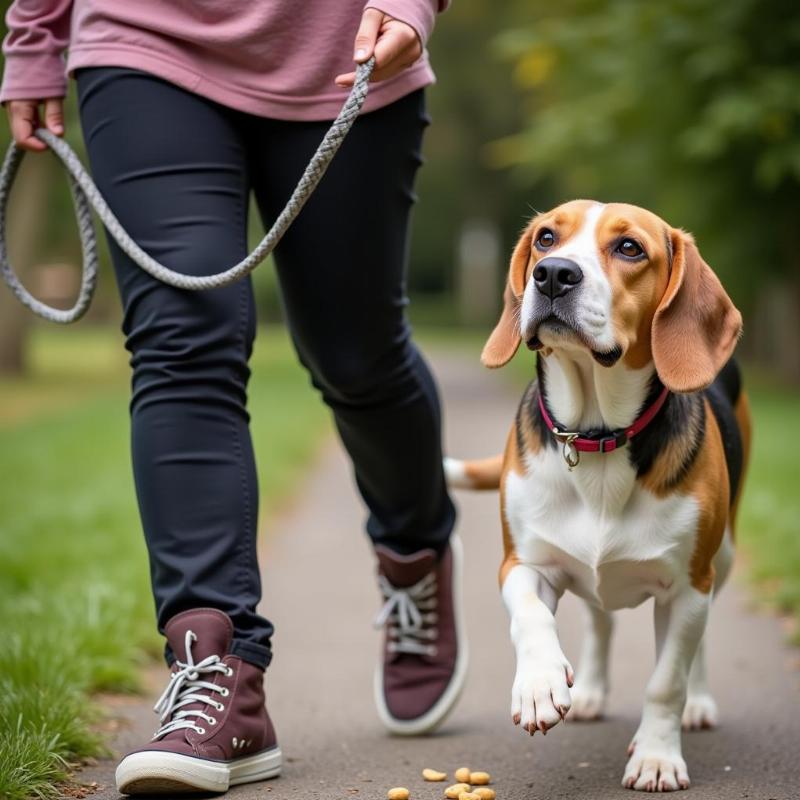Pulling on the lead is a common frustration for many dog owners in the US. It can make walks unpleasant, and even dangerous for both you and your furry friend. Understanding why your dog pulls is the first step to fixing this frustrating behavior. Let’s explore the reasons behind this common issue and how to teach your dog to walk politely on a leash.
A dog pulling on its lead can stem from several factors. It’s not always simply disobedience; sometimes it’s pure excitement to explore the world! From a dog’s perspective, the world is full of fascinating smells and sights, and their natural instinct is to investigate. They might be eager to greet other dogs, chase squirrels, or simply investigate an interesting scent. Understanding their motivation can help you address the root cause of the pulling. Other factors can include improper training, fear, or anxiety. Whatever the reason, there are solutions to help you and your dog enjoy stress-free walks.
Understanding the Reasons Behind the Pull
Several reasons contribute to why your dog might be a lead puller. Identifying the specific cause in your dog is crucial for implementing the right training approach.
Excitement and Exploration
Dogs naturally want to explore their environment. New smells, sights, and sounds are incredibly stimulating, leading them to forge ahead on the leash to investigate. This is particularly true for energetic breeds or puppies experiencing the world for the first time.
Lack of Proper Leash Training
If a dog has never been taught how to walk politely on a leash, pulling will become their default behavior. They simply haven’t learned the alternative. Consistent and positive reinforcement training is essential to teach them proper leash manners.
Fear or Anxiety
Sometimes, pulling can be a fear-based response. A dog might pull in an attempt to escape a perceived threat or uncomfortable situation. This can manifest as lunging, barking, or pulling frantically on the lead. In these cases, addressing the underlying anxiety is key.
Opposition Reflex
Pulling can also be a natural reflexive response. When pressure is applied to a dog’s collar, their instinct is often to pull against it, creating a cycle of pulling and tightening. This is why using a harness is often recommended for pullers.
Effective Strategies to Stop Lead Pulling
Now that we understand the “why”, let’s discuss the “how.” Here are some proven methods to curb your dog’s pulling habit:
Harness Training
Switching from a collar to a front-clip harness can significantly reduce pulling. When your dog pulls, the harness gently steers them back towards you, discouraging the behavior.
Positive Reinforcement
Rewarding your dog for walking politely by your side is a powerful motivator. Use high-value treats and praise when they maintain a loose leash.
 Dog Walking Politely on Leash
Dog Walking Politely on Leash
Consistent Training
Training takes time and consistency. Short, frequent training sessions are more effective than long, sporadic ones. Be patient and persistent, and your dog will eventually learn.
Addressing Underlying Anxiety
If fear or anxiety is the root cause, consult with a certified professional dog trainer or a veterinarian behaviorist. They can help you identify the triggers and develop a desensitization and counterconditioning plan.
Expert Insights
“Many owners unknowingly reinforce pulling behavior by inadvertently allowing their dogs to reach their desired destination while pulling,” says renowned dog trainer, Emily Carter, CPDT-KA. “Consistency in redirecting and rewarding loose-leash walking is crucial for success.”
Dr. Sarah Miller, a veterinary behaviorist, adds, “Identifying the underlying emotional state of your dog is essential. Fear-based pulling requires a different approach than excitement-driven pulling. A tailored behavior modification plan can address the specific needs of your dog.”
Conclusion
Teaching your dog to walk politely on a lead is an investment in your relationship and their well-being. By understanding the reasons behind the pulling and implementing effective training strategies, you can transform your walks into enjoyable experiences for both of you. Remember, patience, consistency, and positive reinforcement are key to achieving loose-leash walking success.
FAQ
- Why does my dog pull more on walks in new places? New environments are full of exciting stimuli, leading to increased excitement and pulling.
- What type of harness is best for a dog that pulls? Front-clip harnesses are generally recommended for pullers as they gently steer the dog back towards you.
- How long does it take to train a dog to stop pulling? The timeframe varies depending on the dog, but consistency is crucial. It may take weeks or even months.
- Should I use a retractable leash for a dog that pulls? Retractable leashes can actually encourage pulling and can be dangerous. A standard 6-foot leash is recommended.
- What if my dog starts pulling again after we’ve made progress? Regression can happen. Return to basic training and reinforce positive behavior.
- Can my older dog learn to stop pulling? Yes! Dogs of all ages can learn new behaviors with consistent training.
- When should I seek professional help for leash pulling? If you are struggling to make progress or suspect fear-based pulling, consult a professional trainer or veterinarian behaviorist.
About Beautdogs.us
Beautdogs.us is your premier source for all things dog-related in the US. We provide expert advice on dog breeds, care, training, and product reviews, catering to both new and experienced dog owners. Our mission is to help you build a strong bond with your canine companion and navigate the joys and challenges of dog ownership with confidence. For any inquiries, reach out to our expert team at [email protected] or call us at +1 501-555-7529. Let Beautdogs.us be your trusted guide on your dog-owning journey.